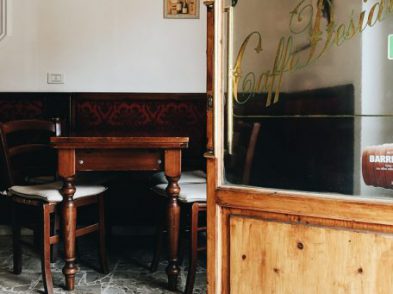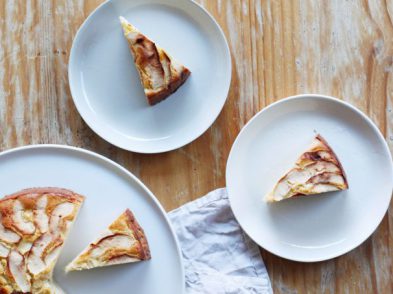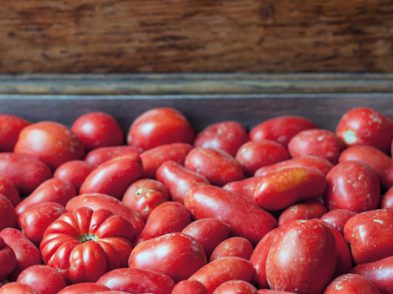In Italy, traditional Easter desserts are usually egg-rich baked goods. Naples’ Easter sweet is pastiera, a ricotta and wheatberry cake scented with orange blossom and candied citron. In Sicily, it is cassata, a sponge cake layered with ricotta, chocolate and candied fruit. Tuscany’s simpler palate is evident in the Easter schiacciata di Pasqua, a fluffy, sweet, crumbly bread not unlike Milan’s panettone, scented with the unmistakeably Tuscan aroma of aniseed.
There are claims that the schiacciata di Pasqua originated in eighteenth-century Fucecchio, a small town along the Arno roughly equidistant from Florence, Pistoia, Lucca, San Gimignano and Pisa. Schiacciata di Pasqua is indeed found in Tuscan towns from Fucecchio to Pisa to Livorno, and even as far south as San Gimignano. Although often known by different names—sportellina in San Gimignano and stiacciata in Livorno and along the Etruscan coast, and even pizza in other areas from southern Tuscany into central Italy—the ingredients are essentially the same, with aniseed the constant in any Tuscan version, but the amounts and other little touches differ.
A long process, the baking of the Easter schiacciata was a tradition of nineteenth-century contadini, the country folks’ way of both using and preserving spring’s abundant eggs. The recipe, a version of which I offer here, needs to be followed with patience and care, letting the bread rise slowly and adding the ingredients in at least two stages, sometimes more. (Perhaps this is why today the schiacciata di Pasqua is usually bought in a bakery.)
This recipe dates back to eighteenth-century Fucecchio. Traditionally, each family would make its own schiacciata di Pasqua, leaving the starter and the dough to rise in the warm spaces of the kitchen. The process would begin at night, after dinner, with family members taking turns checking on the dough throughout the night. Once the dough had risen completely, it would be taken in its copper or terracotta pan to the wood-fired oven of the baker on via delle Valle, together with an egg for brushing on top to get that deep, dark brown crust.
Ideally, schiacciata di Pasqua should be made on Good Friday, so it is ready to go on the table on Easter Sunday. But, to be honest, it is even better when it is a day or two old. It can be revived when it is even older than that with a little dunking in some vin santo. It goes wonderfully well with broken-up pieces of chocolate Easter eggs, too.
RECIPE
Schiacciata di Pasqua from Fucecchio
Ingredients
500g ‘Type 0’ flour, plus 50 g for the starter / 170g sugar / 85g butter / 20ml olive oil / 4 eggs / 28g fresh yeast (or 9g dry yeast) / 15g aniseed / A splash of vin santo / A splash of Sambuca or Strega (or Marsala’) / Pinch of salt / 1 tsp honey / Juice and zest of half an orange / Zest of 1 lemon
Method
Activate the starter by combining the yeast with about 60ml of lukewarm water and 50g of flour. Let it bubble and rise in a warm place until it has doubled in size, about 20 minutes or so. In the meantime, soak the aniseed in the orange juice together with the citrus rinds and honey. Preheat the oven to warm it up to help the dough rise in the next step. Turn it off before it gets too hot—ideally it should be at least 30–40°C.
The first rising (90 minutes)
When the starter has doubled in size, add to it half of the schiacciata ingredients. In other words: 250g of flour, 85g of sugar, 43g of butter, 1 whole egg, 1 egg yolk (save the white for later), 8 g of olive oil, pinch of salt and half of the aniseed mixture. Combine well to obtain an elastic, slightly sticky dough.
Place the dough in a large bowl, covered, inside the warm oven (which should be turned off). Let the dough rise until it is soft and wobbly—it should tremble like a pudding when lightly shaken. This usually takes about 90 minutes, but this can vary greatly depending on the temperature of the kitchen—it can help to re-light the oven to warm it up more during the 90 minutes.
The second rising (3 hours)
When the dough is appropriately wobbly, add the rest of the ingredients. Combine everything well and then place the dough in a greased (traditionally with lard, but you can use olive oil), round, deep baking tin (around 20–26 cm in diameter). Let the dough rise, covered (even swaddled) in tea towels, in a warmed (but unlit) oven, as before, for another 3 hours or, better, overnight. The dough should rise to about three times its original volume and be perfectly round.
Baking (50 minutes)
Brush the top of the dough with the reserved egg whites and bake in moderate oven (150–160°C) for about 50 minutes until springy and dark brown on top. A small saucepan filled with water and placed in the bottom of the oven will help keep the oven humid and create a nice crust.
To serve
Allow it to cool slightly in the pan before attempting to remove it. Let it cool completely and serve it cut into slices. Enjoy on its own, with a small glass of vin santo or chocolate Easter eggs. The bread will keep well, covered in plastic wrap, for a week.
Read more from Emiko Davies’ cookbook Florentine: The True Cuisine of Florence, published by Hardie Grant Books. Order your copy of Florentine: The True Cuisine of Florence here.









